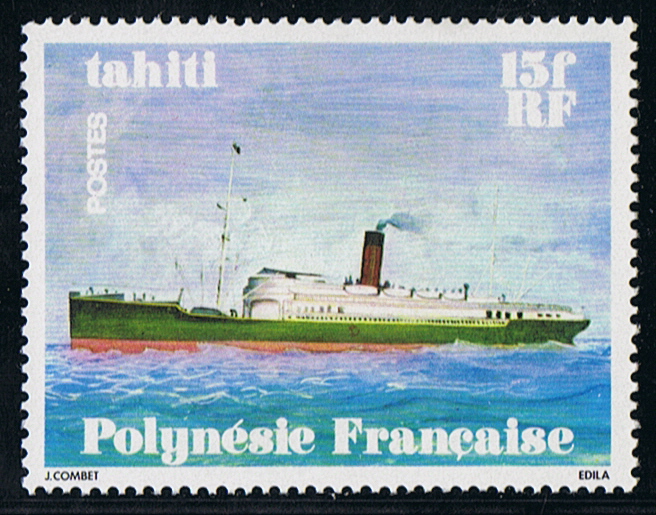
Built as a passenger-cargo vessel under yard No 403 by A. Stephen & Sons, Linthouse, Glasgow for the Imperial Direct West India Mail Co., a subsidiary of Elder, Dempster & Co.
19 April 1904 launched as the PORT KINGSTON.
Tonnage 7.585 gross, 3.841 net, dim. 140.2 x 16.92 x 7.44m.
Powered by two triple expansion steam engines 9.000 ihp., twin screws, speed 17 knots. Trial speed 19 knots.
Accommodation for 160 first class and 60 second class passengers.
Cargo capacity 124.684 cubic feet and 2.528 cubic feet reefer cargo.
July 1904 delivered to owners.
Used in the service between Avonmouth U.K via Bermuda to the West Indies. She was built after Elder, Dempster & Co got a mail contract to the West Indies.
14 January 1907 she almost was driven ashore when she was at anchor when an earthquake almost completely destroyed Kingston, Jamaica. The earthquake killed over 700 people and injured around the 1000.
The PORT KINGSTON grounded twice during the earthquake first when the water receded in the port, thereafter when the water rushed back she was put ashore.
With the help of two tugs and an other ship of the company refloated, and thereafter used as a hospital ship for the wounded people of the town.
1910 Laid up at Bristol after a mail contract not was renewed.
During 1910 the Union S.S. Co of New Zealand re-opened the San Francisco service from down under with two old vessels, but to compete with the more modern American liners she were looking for a faster and more modern vessel for this service.
August 1911 they bought the PORT KINGSTON and renamed her TAHITI.
She was refitted, with her poop deck extended to het main mast.
Passenger accommodation for 277 first class 97 second class and 141 third class passengers.
11 December1911 she left from Sydney for her maiden voyage for her new owners, and via Wellington and Tahiti she sailed to San Francisco.
She was a fast and reliable ship, and she stayed on this service the next three years.
13 August 1914 required by the New Zealand Government, and converted in a troopship at Port Chalmers.
Thereafter named HMNZ troopship No 4.
16 October 1914 she left New Zealand with her first New Zealand troops bound for Egypt.
The next four years she made 5 trooping voyages more between New Zealand and Egypt and sometimes to Great Britain.
12 September 1916 she survived a submarine torpedo attack undamaged in the Mediterranean.
February she used her stern gun to escape from a German submarine in the English Channel.
Between 1917 and 1918 used as troopship across the North Atlantic with American troops.
July 1918 she came under the control of the British War Ministry, thereafter used in the repatriating of New Zealand troops back to New Zealand.
On her first voyage as so she sailed from London on 21 November 1918 and arrived at Dunedin on 12 January 1919.
03 February sailed for Bombay to embark British troops for the U.K.
03 May 1919 she left as troopship for the last time London and after returning home on 04 July at Auckland returned to her owners.
11 August 1919 sailed for Vancouver, where she got a refit and she was converted from coal to oil firing.
April returned to service making first four round voyages to Vancouver from Australasia before in March 1921 returned to the San Francisco service.
During 1923 she made a record passage between Wellington and San Francisco in 16½ day.
03 November 1927 was she in collision with the harbour ferry GREYCLIFF in Sydney harbour, the ferry sank with the loss of 42 lives.
12 August 1930 under command of Capt. A.T. Toten she sailed from Wellington with on board a crew of 145 and 103 passengers and a cargo of 500 tons.
15 August at 04.30 a.m. in a position about 480 miles south-west from Rarotonga (20 43S 166 16W) a violent crashing noises were heard from the starboard main shaft, with very heavy vibration of the ship, followed by violent racing of the starboard engine.
After shutting steam to the engine the cause of the noise was investigated in the shaft tunnel, but before they could investigate a wall of water was nearing them, after a quick retreat a trying to close the bulkhead watertight door but before the door was closed the water reach the door and entered the engineroom.
With all pumps started even hand pumps were rigged the water level was increasing, and a wireless message was sent out announcing the danger the ship was in was sent out.
In the second night the Norwegian steamer PENYBRYN arrived at 10.10 p.m. and stayed standby.
At 09.30 a.m. the conditions of the TAHITI became critical and the order was given that the passengers had to abandon the vessel, in 13 minutes all passengers were in the lifeboats and off the vessel, and were picked up by the American steamer VENTURA who also had arrived.
Then the other boats on board the TAHITI were lowered and all mails and luggage and bullion were loaded on the boats, assisted by one of the boats of the PENYBRYN.
At 01.35 p.m. the position of the crew in the engine room became so dangerous to look after the pumps that the order was given to abandon the vessel.
Shortly when everybody had left the ship she sank stern first, without any loss of life on 17 August. 1930.
French Polynesia 1978 15f sg 284, scott 307.
Source: Elder Dempster Lines by Duncan Haws. Passenger ships of Australia & New Zealand by Peter Plowman. Some web-sites.
